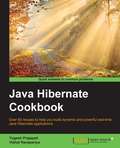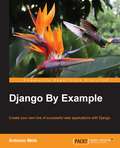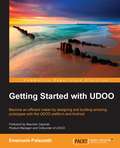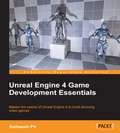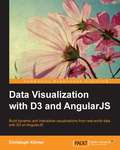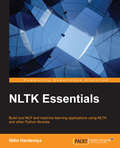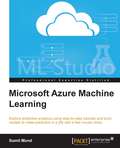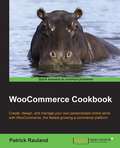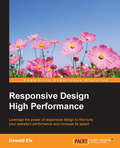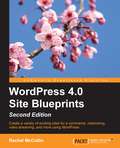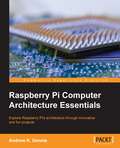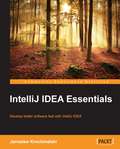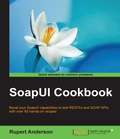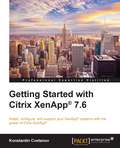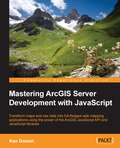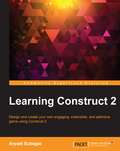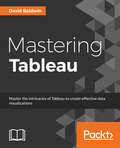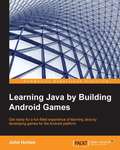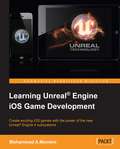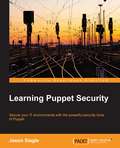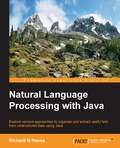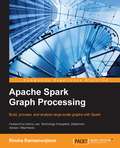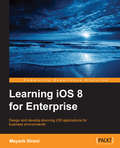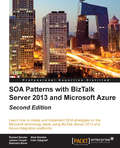- Table View
- List View
Java Hibernate Cookbook
by Yogesh Prajapati Vishal RanapariyaOver 50 recipes to help you build dynamic and powerful real-time Java Hibernate applications About This Book * Learn to associate JDBC and Hibernate with object persistence * Manage association mappings, implement basic annotations and learn caching * Get to grips with Hibernate fundamentals from installation to developing a business application with this step-by-step guide Who This Book Is For This is book for Java developers who now want to learn Hibernate. Good knowledge and understanding of Java is preferred to allow efficient programming of the core elements and applications; it would be helpful if readers are familiar with the basics of SQL. What You Will Learn * Set up and install Hibernate on your system and explore different ways in which Hibernate can be configured * Learn the basic concepts and fundamentals of Java Hibernate * Define mappings without a use of XML file using Annotations * Persist collection elements such as list, map, set and array * Explore the various mapping options and learn to work with Hibernate associations * Understand advanced Hibernate concepts such as caching and inheritance * Develop an engaging and robust real-world hibernate application based on a common business scenario * Integrate Hibernate with other frameworks to develop robust enterprise applications In Detail Hibernate is a database independent technology, so the same code will work for all databases. It helps a Java developer write a query by mapping Java bean to database tables and help create tuned queries that boost performance. Even with limited SQL knowledge one can easily perform database operations. This makes the development faster and more accurate than JDBC. Hibernate supports useful features like connection pooling, caching, and inheritance etc. This book will provide a useful hands-on guide to Hibernate to accomplish the development of a real-time Hibernate application. We will start with the basics of Hibernate, which include setting up Hibernate - the pre-requisites and multiple ways of configuring Hibernate using Java. We will then dive deep into the fundamentals of Hibernate such as SessionFactory, session, criteria, working with objects and criteria. This will help a developer have a better understanding of how Hibernate works and what needs to be done to run a Hibernate application. Moving on, we will learn how to work with annotations, associations and collections. In the final chapters, we will see explore querying, advanced Hibernate concepts and integration with other frameworks. Style and approach This book is a practical guide filled with carefully organized step-by-step instructions. All recipes are arranged in an easy-to understand and clear manner allowing you to apply the solutions to other situations.
Django By Example
by Antonio MeleCreate your own line of successful web applications with Django About This Book * Learn Django by building four fully-functional, real-world web applications from scratch * Develop powerful web applications quickly using the best coding practices * Integrate other technologies into your application with clear, step-by-step explanations and comprehensive example code Who This Book Is For If you are a web developer who is completely new or familiar with Django and want to make the most out of it, this book is for you. Some basic knowledge of Python, HTML, and JavaScript is beneficial, but is not required. What You Will Learn * Build a search engine with Django and Solr * Add asynchronous tasks to applications with Celery * Create pluggable Django applications by building an activity stream system * Enhance the user experience using AJAX views * Extend the Django Admin site with custom actions * Use third-party Django applications to add social authentication to projects * Manage payments and orders by integrating a third-party payment gateway * Engage users by building a gamification system In Detail Django is a powerful Python web framework designed to solve all types of web development problems and questions, providing Python developers with an easy solution to web application development. With a wealth of third-party modules available, you'll be able to create a highly customizable web application with this powerful framework. This book will walk you through the creation of four professional Django projects and show you how to solve common problems and implement best practices. The book begins by first showing you how to create a simple blog and integrate it with third-party applications, before gradually moving on to extending this blog by adding features such as custom template tags and filters. You will build a complete social website, share its contents, track user actions in a timeline, and use Redis with Django to store item views. You will also build an online shop, manage its payments and orders, and add internationalization and localization to the project. Before you are introduced to content creation and building an evaluation system, you will build an e-learning application. Finally, you will build a gamification system where you will learn to build a badges application and get familiar with Django management commands. After reading this book, you will have a good understanding of how Django works and how to integrate it with other technologies. You will be able to build advanced Django applications for production use. Style and approach This is an easy-to-follow guide to building four different production-ready Django projects. Each project focuses on a particular area of the framework and each topic within the projects is explained with practical examples and includes best practice recommendations.
Getting Started with UDOO
by Emanuele PalazzettiIf you are an Android developer who wants to learn how to use UDOO to build Android applications that are capable of interacting with their surrounding environment, then this book is ideal for you. Learning UDOO is the next great step to start building your first real-world prototypes powered by the Android operating system.
Unreal Engine 4 Game Development Essentials
by Satheesh PvMaster the basics of Unreal Engine 4 to build stunning video games About This Book * Get to grips with the user interface of Unreal Engine 4 and find out more about its various robust features * Create dream video games with the help of the different tools Unreal Engine 4 offers * Create video-games and fully utilize the power of Unreal Engine 4 to bring games to life through this step-by-step guide Who This Book Is For If you have a basic understanding of working on a 3D environment and you are interested in video game development, then this book is for you. A solid knowledge of C++ will come in handy. What You Will Learn * Download both the binary and source version of Unreal Engine 4 and get familiar with the UI * Get to know more about the Material Editor and how it works * Add a post process to the scene and alter it to get a unique look for your scene * Acquaint yourself with the unique and exclusive feature of Unreal Engine 4--Blueprints * Find out more about Static and Dynamic lighting and the difference between various lights * Use Matinee to create cut scenes * Create a health bar for the player with the use of Unreal Motion Graphics (UMG) * Get familiar with Cascade Particle Editor In Detail Unreal Engine 4 is a complete suite of game development tools that gives you power to develop your game and seamlessly deploy it to iOS and Android devices. It can be used for the development of simple 2D games or even stunning high-end visuals. Unreal Engine features a high degree of portability and is a tool used by many game developers today. This book will introduce you to the very popular Unreal 4 engine with hands-on instructions to build stunning video games. You will begin by creating a new project or prototype by learning the essentials of Unreal engine, then you'll get an understanding of how the World Browser can help to improve performance of our game. Next, we'll create a level of detailed models and materials to further improve performance. After that, you'll see how to import textures, create different materials, and see what materials can do in terms of post-processing. Finally, you will get acquainted with the Paper2D tool and the blueprints system to further increase our project's performance with Engine's scalability tools. Style and approach This step-by-step guide will help you gain practical knowledge about Unreal Engine through detailed descriptions of all the tools offered by Unreal Engine.
GameSalad Essentials
by Miguel DequadrosIf you want to create your own game, but don't know where to start, this is the book for you. Whether you've used GameSalad before, or have prior game development experience or not you are sure to learn! Imaging software experience, such as Photoshop, is good to have, but art and assets are provided in the book's resources.
Data Visualization with D3 and AngularJS
by Christoph Korner<P><P>Build dynamic and interactive visualizations from real-world data with D3 on AngularJS <P><P>About This Book <P><P>Explore the powerful vector graphics capabilities of modern browsers to build customized cross-platform visualizations using D3.js's data-driven techniques <P><P>Learn how to modularize a visualization into reusable and testable components using the powerful concepts of modern web application design with AngularJS <P><P>This is a step-by-step learning guide closely focused on developing responsive data visualization apps and AngularJS best practices with D3.js <P><P>Who This Book Is For <P><P>If you are a web developer with experience in AngularJS and want to implement interactive visualizations using D3.js, this book is for you. Knowledge of SVG or D3.js will give you an edge to get the most out of this book. <P><P>What You Will Learn <P><P>Design, implement, and integrate an interactive dashboard to visualize server logs in real time using D3 graphics <P><P>Learn cross-platform vector graphics to implement a dashboard visualization <P><P>Perform data-driven transformations on selected HTML and SVG nodes <P><P>Map, group, and filter datasets and create scales and axes <P><P>Modularize data visualization information into reusable components to seamlessly integrate them into an AngularJS application <P><P>Load, parse, and preprocess external data and autoupdate the visualization <P><P>Design various chart types such as scatter, line, bar, or area and extend built-in shapes <P><P>Create custom animations and transitions for the visualization <P><P>Implement interactions and controls for the visualization preserving two-way binding between D3 and AngularJS components <P><P>In Detail <P><P>Using D3.js, the powerful JavaScript toolkit for creating cross-platform vector graphics, you can now combine performance with maximum compatibility to build a web-based visualization and present data in an interactive and convenient way. We'll reach top-notch reusability and testability by combining D3 graphics with our favorite web application framework, AngularJS. <P><P>This book teaches the basics of vector graphics, D3, and AngularJS integration, and then dives into controlling, manipulating, and filtering data. You will learn about the testability of components and how to implement custom interactions, filters, and controllers; discover how to parse and map data in D3.js; and get a grasp on drawing D3.js built-in shapes and curves. After reading the last few chapters, you'll be able to bring life to your visualizations with more features of D3.js such as interactions, animations, and transitions. You will finish your journey by implementing a parser for different server application logs and display them on a Google Analytics style interactive dashboard.
NLTK Essentials
by Nitin HardeniyaIf you are an NLP or machine learning enthusiast with some or no experience in text processing, then this book is for you. This book is also ideal for expert Python programmers who want to learn NLTK quickly.
Microsoft Azure Machine Learning
by Sumit MundThe book is intended for those who want to learn how to use Azure Machine Learning. Perhaps you already know a bit about Machine Learning, but have never used ML Studio in Azure; or perhaps you are an absolute newbie. In either case, this book will get you up-and-running quickly.
WooCommerce Cookbook
by Patrick RaulandIf you have ever built or managed a WordPress site and want to add e-commerce functionality into your site, WooCommerce and this book are perfect for you. Learning how to use WooCommerce through this series of recipes will give you a solid platform to add any future e-commerce needs.
Responsive Design High Performance
by Dewald ElsThis book is ideal for developers who have experience in developing websites or possess minor knowledge of how responsive websites work. No experience of high-level website development or performance tweaking is required.
WordPress 4.0 Site Blueprints - Second Edition
by Rachel MccollinCreate a variety of exciting sites for e-commerce, networking, video streaming, and more, using WordPress About This Book * Build ten different types of website using WordPress * Transfer your static site to WordPress and create sites to make money, build communities, and share your ideas * The projects in the book will teach you how to use free themes and plugins without any prior coding experience Who This Book Is For WordPress Site Blueprints is suitable for new or experienced WordPress users. You don't need to be a PHP developer or have ever created a WordPress theme or plugin. Instead the book will help you use themes and plugins (all free) to create a wide range of sites. Familiarity with the WordPress interface will help you but you don't need to be able to write code. What You Will Learn * Migrate your old static site into WordPress * Create a network of sites for other people to work with each other * Build a great store using the free WooCommerce plugin * Create a video streaming site linked to YouTube * Create a review site for products, services, or anything you'd like * Create a jobs board so people can post jobs and apply for them * Create websites that focus on networking such as a social media site, a communications center for your team, and a membership site to build a community * Create a beautiful gallery site to showcase your photography In Detail WordPress is the world's most popular Content Management System (CMS) and you can use it to create any kind of site you or your clients need. Using free plugins and themes for WordPress, you can create a store, a social media site, a review site, a video site, a network of sites or a community site, and more. Wordpress makes your job of creating your own website simple and hassle-free! If you've started using WordPress to create a blog or simple website, you'll have had a taste of the opportunities offered by this massively popular CMS. This book will take you through the process of creating ten popular kinds of site using WordPress with free plugins and themes, each chapter covering various functionality of the web. After having learned how to migrate from your static site to Wordpress in the first chapter, you will then explore the world of social networking websites followed focusing on e-commerce. Without writing too much code, you'll be able to create a store, a video streaming site, a team communications site, a jobs board, and more. This book is a one-stop solution to resolve all your worries about creating a website that will give the best experience to your users. Style and approach A project-based step-by-step guide to creating ten different types of popular website using WordPress. This book takes you through clear and logical steps, with screenshots and tips along the way to help you follow the guide and learn how to get more from WordPress.
Raspberry Pi Computer Architecture Essentials
by Andrew K. DennisExplore Raspberry Pi's architecture through innovative and fun projects About This Book * Explore Raspberry Pi 2's hardware through the Assembly, C/C++, and Python programming languages * Experiment with connecting electronics up to your Raspberry Pi 2 and interacting with them through software * Learn about the Raspberry Pi 2 architecture and Raspbian operating system through innovative projects Who This Book Is For Raspberry Pi Computer Architecture Essentials is for those who are new and those who are familiar with the Raspberry Pi. Each topic builds upon earlier ones to provide you with a guide to Raspberry Pi's architecture. From the novice to the expert, there is something for everyone. A basic knowledge of programming and Linux would be helpful but is not required. What You Will Learn * Set up your Raspberry Pi 2 and learn about its hardware * Write basic programs in Assembly Language to learn about the ARM architecture * Use C and C++ to interact with electronic components * Find out about the Python language and how to use it to build web applications * Interact with third-party microcontrollers * Experiment with graphics and audio programming * Expand Raspberry Pi 2's storage mechanism by using external devices * Discover Raspberry Pi 2's GPIO pins and how to interact with them In Detail With the release of the Raspberry Pi 2, a new series of the popular compact computer is available for you to build cheap, exciting projects and learn about programming. In this book, we explore Raspberry Pi 2's hardware through a number of projects in a variety of programming languages. We will start by exploring the various hardware components in detail, which will provide a base for the programming projects and guide you through setting up the tools for Assembler, C/C++, and Python. We will then learn how to write multi-threaded applications and Raspberry Pi 2's multi-core processor. Moving on, you'll get hands on by expanding the storage options of the Raspberry Pi beyond the SD card and interacting with the graphics hardware. Furthermore, you will be introduced to the basics of sound programming while expanding upon your knowledge of Python to build a web server. Finally, you will learn to interact with the third-party microcontrollers. From writing your first Assembly Language application to programming graphics, this title guides you through the essentials. Style and approach This book takes a step-by-step approach to exploring Raspberry Pi's architecture through projects that build upon each other. Each project provides you with new information on how to interact with an aspect of the Raspberry Pi and Raspbian operating system, providing a well-rounded guide.
IntelliJ IDEA Essentials
by Jaroslaw KrochmalskiThis book is for developers who want to work smarter so they can focus their efforts on the details that will give them the advantage. This book is tailor-made for developers who want to move from NetBeans and Eclipse to experience the power and functionality of IntelliJ IDEA.
SoapUI Cookbook
by Rupert AndersonThis book is aimed at developers and technical testers who are looking for a quick way to take their SoapUI skills and understanding to the next level. Even if you are new to SoapUI but have basic Java skills and a reasonable grasp of RESTFul and Soap web services, then you should have no problem making use of this book.
Getting Started with Citrix XenApp® 7.6
by Konstantin CvetanovInstall, configure, and support your XenApp systems with the power of Citrix XenAppAbout This BookFamiliarize yourself with Citrix applications and desktop virtualizationMaintain and troubleshoot your XenApp environment to minimize system downtime. <P><P>A hands-on, step-by-step guide with a practical approach and real-world examples to get you up and running with XenApp systemsWho This Book Is ForThis book is intended for IT administrators and consultants who want to build application and desktop virtualization solutions for their employers and customers. No prior knowledge of Citrix technologies is required.What You Will LearnMake the use case for Citrix XenApp and design your first systemPrepare your existing IT infrastructure for XenApp and learn what licenses you needInstall and configure the XenApp infrastructureEnable access with StoreFront and NetScaler GatewayEnable load balancing with NetScalerMaintain servers and publish applications and desktopsManage printing in a Citrix environmentTroubleshoot your environment using advanced tools and methodologies employed by Citrix Escalation TeamsIn DetailIf you want to effectively deploy the various components of Citrix XenApp to create an enterprise environment for application and desktop delivery, this hands-on guide is perfect for you. You start off by understanding the need and benefits of Citrix XenApp with respect to Virtualization technology. After this, you will get to grips with the requirement analysis and designing aspect of building XenApp systems and all the necessary installation and configuration procedures for Citrix XenApp, StoreFront and NetScalar Gateway are explained one by one in detail.Step-by-step, you will learn to deploy your first XenApp with the Machine Creation Services method and Provisioning Services method. After this, you will explore the administering part of applications and systems, followed by printing in the XenApp environment. Next, you will learn all the trips and tricks required to troubleshoot and support the XenApp environment. By the end of this book, you will be ready to go live with your new XenApp environment.Style and approachThis is a step-by-step guide to technical implementations in a conversational and easy-to-follow style. Each component is deployed sequentially until a full solution is built. Basic as well as advanced features of the product are explored to appeal to the widest possible audience interested in the topic.
Mastering ArcGIS Server Development with JavaScript
by Ken DomanTransform maps and raw data into full-fledged web mapping applications using the power of the ArcGIS JavaScript API and JavaScript libraries About This Book * Create and share modern map applications for desktops, tablets, and mobile browsers * Present and edit geographic and related data through maps, charts, graphs, and more * Learn the tools, tips, and tricks made available through the API and related libraries with examples of real-world applications Who This Book Is For This book is intended for intermediate developers who want to design web mapping applications. You should have some experience with geographic information systems, especially with ArcGIS products such as ArcGIS Server. It also helps to have some experience with HTML, CSS, and JavaScript. What You Will Learn * Create single-page mapping applications, lining up data from different sources * Search for and display geographic and tabular information based on locations and attributes * Customize maps and widgets to deliver the best user experience * Present location data intuitively using charts and graphs * Integrate mapping applications with your favorite JavaScript frameworks * Test the working of your web map application and take advantage of cloud services such as ArcGIS Online * Create modern-looking web maps through styling tips and tricks In Detail ESRI and its ArcGIS line of software have been an industry leader in digital map production and publication for over 30 years. ArcGIS Server lets you design, configure, and publish maps that can be viewed and edited through the Internet. After designing basic maps, you may want to find out new and innovative ways to represent information using these maps. In this book, you'll work through practical examples, experiencing the pitfalls and successes of creating desktop and mobile map applications for a web browser using the ArcGIS Server platform. The book begins by introducing you to ArcGIS Server and ESRI's JavaScript API. You'll work with your first web map and then move on to learn about ESRI's building blocks. A Dojo AMS style widget will help you create your own widgets for a map and then see how to collect geographic data. Furthermore, you will learn different techniques such as using Dojo Charts to create charts and graphs to represent your data. Then you will see how to use ESRI JavaScript API with other JavaScript libraries and different styling methods to make your map stand out. By the end of the book, you will discover how to make your application compatible with different devices and platforms and test it using testing libraries. Style and approach An in-depth guide that explores web application development using ArcGIS Server and the ArcGIS JavaScript API. Topics are explained in the context of developing two applications for fictional clients. Details of application development, including possible pitfalls and best practices, are included in this book.
Learning Construct 2
by Aryadi SubagioIf you want to make your own game but don't know how to start or don't have the technical skills to do it, then this is the book for you. You don't need to have a programming background to understand the concepts explained.
Mastering Tableau
by David BaldwinMaster the intricacies of Tableau to create effective data visualizations About This Book * Arm yourself with an arsenal of advanced chart types and geocoding to efficiently and engagingly present information * Map a grid over a network node diagram and use that grid to demonstrate loads, processing time, and more in Tableau * Integrate R with Tableau by utilizing R functions, libraries, and saved models Who This Book Is For If you are a business analyst without developer-level programming skills, then this book is for you. You are expected to have at least a fundamental understanding of Tableau and basic knowledge of joins, however SQL knowledge is not assumed. You should have basic computer skills, including at least moderate Excel proficiency. What You Will Learn * Create a worksheet that can display the current balance for any given period in time * Recreate a star schema from in a data warehouse in Tableau * Combine level of detail calculations with table calculations, sets, and parameters * Create custom polygons to build filled maps for area codes in the USA * Visualize data using a set of analytical and advanced charting techniques * Know when to use Tableau instead of PowerPoint * Build a dashboard and export it to PowerPoint In Detail Tableau has emerged as one of the most popular Business Intelligence solutions in recent times, thanks to its powerful and interactive data visualization capabilities. This book will empower you to become a master in Tableau by exploiting the many new features introduced in Tableau 10.0. You will embark on this exciting journey by getting to know the valuable methods of utilizing advanced calculations to solve complex problems. These techniques include creative use of different types of calculations such as row-level, aggregate-level, and more. You will discover how almost any data visualization challenge can be met in Tableau by getting a proper understanding of the tool's inner workings and creatively exploring possibilities. You'll be armed with an arsenal of advanced chart types and techniques to enable you to efficiently and engagingly present information to a variety of audiences through the use of clear, efficient, and engaging dashboards. Explanations and examples of efficient and inefficient visualization techniques, well-designed and poorly designed dashboards, and compromise options when Tableau consumers will not embrace data visualization will build on your understanding of Tableau and how to use it efficiently. By the end of the book, you will be equipped with all the information you need to create effective dashboards and data visualization solutions using Tableau. Style and approach This book takes a direct approach, to systematically evolve to more involved functionalities such as advanced calculation, parameters & sets, data blending and R integration. This book will help you gain skill in building visualizations previously beyond your capacity.
Learning Java by Building Android Games
by John Horton<P><P>Key Features <P><P>Acquaint yourself with Java and object-oriented programming, from zero previous experience <P><P>Build four cool games for your phone and tablet, from retro arcade-style games to memory and education games, and gain the knowledge to design and create your own games too <P><P>Walk through the fundamentals of building games and use that experience as a springboard to study advanced game development or just have fun <P><P>Book Description <P><P>Android is the fastest growing operating system (OS) with one of the largest installed bases of any mobile OS. Android uses one of the most popular programming languages, Java, as the primary language for building apps of all types. So, you should first obtain a solid grasp of the Java language and its foundation APIs to improve the chances of succeeding as an Android app developer. <P><P>This book will show you how to get your Android development environment set up and you will soon have your first working game. The difficulty level grows steadily with the introduction of key Java topics such as loops, methods, and OOP. You'll then use them in the development of games. You will learn how to build a math test game, a Simon-like memory game, a retro pong-style game, and for the grand finale, a Snake-style, retro arcade game with real Google Play leaderboards and achievements. The book has a hands-on approach and is packed with screenshots. <P><P>What You Will Learn <P><P>Set up an efficient, professional game development environment in Android Studio <P><P>Build your very own Android UI using easy to-use tools in Android Studio <P><P>Add real-time interaction with Java threads and implement locking/handling screen rotation, pixel graphics, clicks, animation, sound FX, and many other features in your games <P><P>Explore object-oriented programming (OOP) and design scalable, reliable, and well-written Java games or apps on almost any Android device <P><P>Build and deploy a graphical pong-style game using advanced OOP concepts <P><P>Explore APIs and implement advanced features such as online leaderboards and achievements using Google game services Make your game compelling to be the next big hit on Google Play market with a content update strategy and in-game marketing
Learning Unreal® Engine iOS Game Development
by Muhammad A. MoniemIf you are a game developer, designer, artist, or a beginner in the gaming industry, and want to make iOS games efficiently at a low cost, this book is ideal for you.
Learning Puppet Security
by Jason SlagleIf you are a security professional whose workload is increasing, or a Puppet professional looking to increase your knowledge of security, or even an experienced systems administrator, then this book is for you. This book will take you to the next level of security automation using Puppet. The book requires no prior knowledge of Puppet to get started.
Natural Language Processing with Java
by Richard M ReeseIf you are a Java programmer who wants to learn about the fundamental tasks underlying natural language processing, this book is for you. You will be able to identify and use NLP tasks for many common problems, and integrate them in your applications to solve more difficult problems. Readers should be familiar/experienced with Java software development.
Apache Spark Graph Processing
by Rindra RamamonjisonThis book is for data scientists and big data developers who want to learn the processing and analyzing graph datasets at scale. Basic programming experience with Scala is assumed. Basic knowledge of Spark is assumed.
Learning iOS 8 for Enterprise
by Mayank BiraniIf you are an experienced iPhone application developer or even a newbie, this book will help you to build on and explore your technical skills. This book is very helpful for those who want to learn about the new framework of iOS 7 and iOS 8.
SOA Patterns with BizTalk Server 2013 and Microsoft Azure - Second Edition
by Richard Seroter Mark BrimbleIf you are a developer who has been tasked with building service-oriented BizTalk Server solutions, this book is for you. It will help you to envision an enterprise solution and implement the software blueprint.
